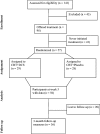Early Treatment Response in Children and Adolescents Receiving CBT for Trauma
- PMID: 25362103
- PMCID: PMC4710179
- DOI: 10.1093/jpepsy/jsu096
Early Treatment Response in Children and Adolescents Receiving CBT for Trauma
Abstract
Objectives: To investigate the incidence and correlates of early treatment response among youth receiving cognitive behavioral therapy (CBT) for posttraumatic stress disorder (PTSD).
Methods: 56 youth who participated in a randomized controlled trial of CBT for PTSD and D-cycloserine were included. Youth with PTSD symptoms below clinical cutoff after Session 4 of a 12-session protocol were classified as early treatment responders (32% of parent reports, 44.6% of child reports). Pretreatment characteristics were examined in relation to responder status.
Results: Lower levels of pretreatment PTSD, depression, and anxiety symptoms and fewer trauma types were related to child- and parent-reported responder status (d = .57, d = .52, respectively). Early treatment response was maintained at follow-up.
Conclusions: Pretreatment symptoms levels and number of traumas may play an important role in predicting early treatment response. Correlates of early treatment response may provide avenues for identifying youth who could benefit from abbreviated protocols.
Keywords: PTSD; children and adolescents; cognitive behavior therapy; early treatment response.
© The Author 2014. Published by Oxford University Press on behalf of the Society of Pediatric Psychology. All rights reserved. For permissions, please e-mail: journals.permissions@oup.com.
Figures
Similar articles
-
Randomized placebo-controlled D-cycloserine with cognitive behavior therapy for pediatric posttraumatic stress.J Child Adolesc Psychopharmacol. 2014 Mar;24(2):69-77. doi: 10.1089/cap.2013.0106. Epub 2014 Feb 7. J Child Adolesc Psychopharmacol. 2014. PMID: 24506079 Free PMC article. Clinical Trial.
-
Effectiveness of abbreviated trauma-focused cognitive behavioural therapy for South African adolescents: a randomized controlled trial.Eur J Psychotraumatol. 2023;14(1):2181602. doi: 10.1080/20008066.2023.2181602. Eur J Psychotraumatol. 2023. PMID: 37052081 Free PMC article. Clinical Trial.
-
Psychological therapies for the treatment of post-traumatic stress disorder in children and adolescents (Review).Evid Based Child Health. 2013 May;8(3):1004-116. doi: 10.1002/ebch.1916. Evid Based Child Health. 2013. PMID: 23877914 Review.
-
Comparison of eye movement desensitization and reprocessing therapy, cognitive behavioral writing therapy, and wait-list in pediatric posttraumatic stress disorder following single-incident trauma: a multicenter randomized clinical trial.J Child Psychol Psychiatry. 2017 Nov;58(11):1219-1228. doi: 10.1111/jcpp.12768. Epub 2017 Jun 28. J Child Psychol Psychiatry. 2017. PMID: 28660669 Clinical Trial.
-
Treating Children and Adolescents with Posttraumatic Stress Disorder: Moderators of Treatment Response.J Clin Child Adolesc Psychol. 2021 Jul-Aug;50(4):510-516. doi: 10.1080/15374416.2020.1823849. Epub 2020 Oct 13. J Clin Child Adolesc Psychol. 2021. PMID: 33047981 Review.
Cited by
-
Lost in Transition? Evidence-Based Treatments for Adolescents and Young Adults with Posttraumatic Stress Disorder and Results of an Uncontrolled Feasibility Trial Evaluating Cognitive Processing Therapy.Clin Child Fam Psychol Rev. 2020 Mar;23(1):122-152. doi: 10.1007/s10567-019-00305-0. Clin Child Fam Psychol Rev. 2020. PMID: 31620891 Review.
-
CBT+ Training Initiative in Washington State Community Mental Health: An Evaluation of Child Clinical Outcomes.Community Ment Health J. 2024 May;60(4):649-661. doi: 10.1007/s10597-023-01194-y. Epub 2023 Oct 26. Community Ment Health J. 2024. PMID: 37880492 Free PMC article.
-
Family therapy and EMDR after child abuse and neglect: moderating effects of child attachment style and PTSD symptoms on treatment outcome.Eur J Psychotraumatol. 2024;15(1):2416288. doi: 10.1080/20008066.2024.2416288. Epub 2024 Oct 25. Eur J Psychotraumatol. 2024. PMID: 39450451 Free PMC article.
-
Youth Top Problems and Early Treatment Response to the Unified Protocols for Transdiagnostic Treatment of Emotional Disorders in Children and Adolescents.Child Psychiatry Hum Dev. 2022 Jun;53(3):582-598. doi: 10.1007/s10578-021-01151-4. Epub 2021 Mar 17. Child Psychiatry Hum Dev. 2022. PMID: 33733398
-
Predictors of nonresponse and drop-out among children and adolescents receiving TF-CBT: investigation of client-, therapist-, and implementation factors.BMC Health Serv Res. 2022 Sep 29;22(1):1212. doi: 10.1186/s12913-022-08497-y. BMC Health Serv Res. 2022. PMID: 36175864 Free PMC article.
References
-
- Allen B., Gharagozloo L., Johnson J. C. (2012). Clinician knowledge and utilization of empirically-supported treatments for maltreated children. Child Maltreatment, 17, 11–21. - PubMed
-
- Birmaher B., Khetarpal S., Brent D., Cully M., Balach L., Kaufman J., Neer S. M. (1997). The screen for child anxiety related emotional disorders (SCARED): Scale construction and psychometric characteristics. Journal of the American Academy of Child and Adolescent Psychiatry, 36, 545–553. - PubMed
-
- Carle A. C., Millsap R., Cole D. A. (2008). Measurement bias across gender on the Children's Depression Inventory. Educational & Psychological Measurement, 68, 281–303.
-
- Carrión V. G., Kletter H., Weems C. F., Berry R. R., Rettger J. P. (2013). Cue-centered treatment for youth exposed to interpersonal violence: A randomized controlled trial. Journal of Traumatic Stress, 26, 654–662. - PubMed
Publication types
MeSH terms
Grants and funding
LinkOut - more resources
Full Text Sources
Other Literature Sources
Medical



